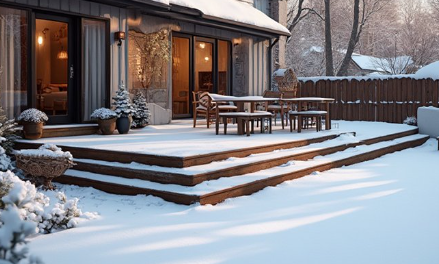
Snow accumulation threatens deck integrity in ways many homeowners don't anticipate. Drawing from insights shared by AAA Fence and Deck, a leading deck builder in Raleigh, proper snow management stands as a critical factor in deck preservation and safety.
The battle against winter weather demands more than just occasional snow removal. A strategic approach to winter deck care protects your investment from moisture damage, structural stress, and the relentless freeze-thaw cycles that challenge deck durability.
Pre-Winter Deck Preparation
A thorough cleaning before winter arrives creates a protective foundation for your deck. Remove all debris, furniture, and planters that could trap moisture and cause staining or discoloration.
Apply a high-quality water-repellent sealant to create a protective barrier against moisture. This step proves particularly crucial for wooden decks, as it helps prevent water absorption and reduces the risk of warping and cracking.
Snow Removal Techniques
Using the correct tools and methods for snow removal prevents damage to deck surfaces. Always opt for plastic snow shovels rather than metal ones, as metal can scratch and gouge deck materials.
Shovel in the direction of deck boards to minimize the risk of surface damage. For light snowfall, a push broom often proves sufficient and poses minimal risk to the deck surface.
Weight Management Strategies
Fresh snow might seem light, but accumulation can add significant weight to your deck structure. Ten to twelve inches of fresh snow equals about five pounds per square foot, while packed snow becomes considerably heavier.
Regular removal prevents excessive weight buildup that could stress deck supports. Never allow snow accumulation to exceed four feet, as this can approach dangerous load limits, especially when rain or sleet adds to the weight.
Ice Management Solutions
Avoid using standard rock salt or calcium chloride products on deck surfaces, as these can damage both wood and composite materials. Instead, choose deicing products specifically formulated for deck use.
Consider using sand for traction, but be aware that it may cause minor surface scratching. Calcium Magnesium Acetate (CMA) offers a safer alternative for ice management on wooden decks.
Material-Specific Considerations
Different decking materials require specific care approaches during winter. Composite decking generally handles moisture better than wood but still needs regular snow removal to prevent surface damage.
Pressure-treated lumber requires extra attention to prevent moisture-related issues. Regular inspection during winter months helps identify potential problems before they become severe.
Protective Covering Options
Using a tarp as an additional barrier can help protect deck surfaces from direct snow contact. This extra layer reduces moisture exposure and makes snow removal easier.
Ensure proper tarp installation to prevent wind damage and allow adequate ventilation. Remove accumulated snow from the tarp regularly to prevent excessive weight on the deck structure.
Post-Storm Inspection
After significant snow events, check deck structures for signs of stress or damage. Pay particular attention to joints, fasteners, and support posts where snow accumulation might have caused strain.
Document any concerns and address them promptly to prevent more extensive damage. Regular inspections help maintain deck safety and identify maintenance needs early.
Drainage Management
Proper drainage becomes crucial during winter months when snow melts. Clear all drainage channels and ensure water can flow freely away from your deck structure to prevent pooling and ice formation.
Regular checks of gutters and downspouts near your deck help prevent ice dams and water backup. Installing heat cables near problem areas can help maintain proper water flow during freeze-thaw cycles.
Professional Inspection Schedule
Annual professional deck inspections before winter help identify potential structural issues that could worsen under snow loads. These evaluations should focus on support posts, joists, and connection points that bear the most weight.
Professional inspectors can spot early signs of wear that homeowners might miss, such as subtle joint separation or beginning stages of rot. Addressing these issues before winter prevents more serious problems from developing under harsh conditions.

Winter deck maintenance requires consistent attention and proper techniques to prevent damage and ensure safety. Regular snow removal, appropriate ice management, and careful material selection for maintenance tools play crucial roles in winter deck care.
For professional guidance on deck maintenance or to discuss upgrading your current deck to withstand winter conditions better, consider consulting with a local deck-building expert. Their expertise can help ensure your outdoor space remains safe and beautiful throughout the winter season.



(0) comments
We welcome your comments
Log In
Post a comment as Guest
Keep it Clean. Please avoid obscene, vulgar, lewd, racist or sexually-oriented language.
PLEASE TURN OFF YOUR CAPS LOCK.
Don't Threaten. Threats of harming another person will not be tolerated.
Be Truthful. Don't knowingly lie about anyone or anything.
Be Nice. No racism, sexism or any sort of -ism that is degrading to another person.
Be Proactive. Use the 'Report' link on each comment to let us know of abusive posts.
Share with Us. We'd love to hear eyewitness accounts, the history behind an article.